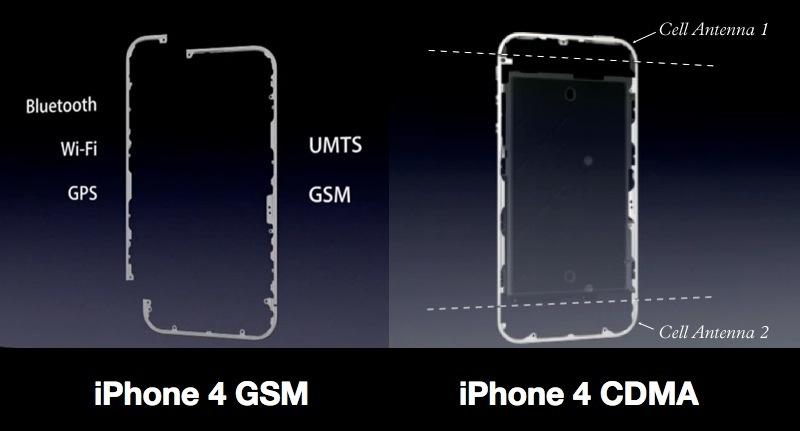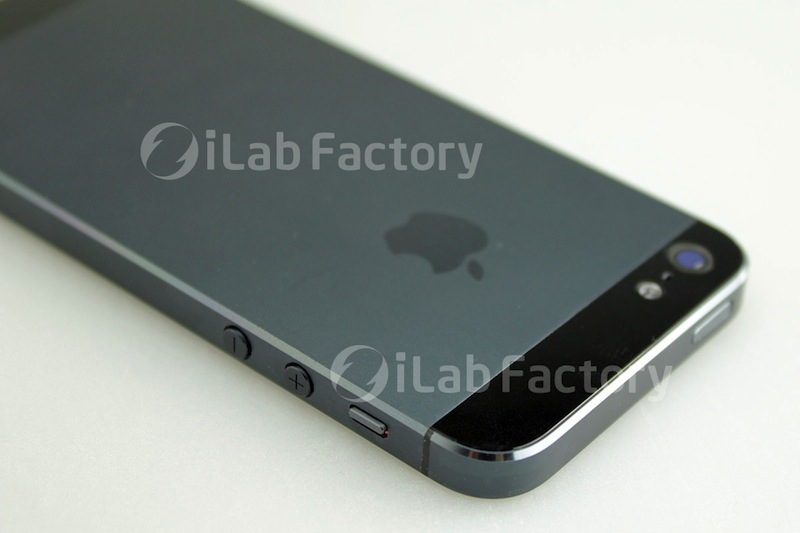Lehman examined rumored iPhone 5 components on The Tech Block, noting "two things stand out right away: A 'taller' proportion compared to traditional iPhones and the wraparound metal backplate."
Evolution of the iPhone 4 antennas
Rumors of a taller, 4 inch screen have been widely discussed, but Lehman focuses on the progression of Apple's iPhone 4 design, which Steve Jobs first unveiled in 2010 (after the new design had leaked following the loss of a prototype).
While the initial iPhone 4 (GSM) model used its "exoskeleton" metal band as two long antenna segments, Apple revised the design when it introduced a CDMA version for Verizon Wireless in order to accommodate Verizon's requirements of a dual-antenna design for its cellular network.
The subsequent iPhone 4S design retained the same top and bottom, dual cellular antenna design, while transmitting GPS, WiFi and Bluetooth radio signals through the phone's rear glass panel.
New unibody case design
Lehman notes that "the leaked [iPhone 5] design has three pieces of metal instead of four. It still has two U-shaped pieces at the top and bottom, but this time the two flat sides become one single piece of metal that also comprises the back of the device. That single piece of metal is the unibody backplate."
He adds, "same properties that unibody designs give to Apple’s laptops apply to this design as well: stronger, lighter, and thinner."
As with Apple's unibody MacBooks and iPad shells, it appears the iPhone 5's new one piece backplate and sides is milled from a single piece of metal, with integrated "bosses" that provide points to screw down the logic board and other internal components.
The new design eliminates the full glass back of the phone, and reduces its thickness considerably, essentially making it as thin as the band, about 2-3 mm thinner than today's iPhone 4S.
"That sounds small, but it’s a huge difference," Lehman writes. "That’s as much as 32 percent thinner. As a point of comparison, the Retina MacBook Pro is only 25 percent thinner than the old MacBook Pro."
Lehman adds, "the cell antenna is integrated into the metal case, but there are still separate Wi-Fi, GPS, Bluetooth, and (potentially) NFC antennas to deal with. They need to transmit their signal through non-signal-blocking materials such as plastic or glass.
"That was why the original iPhone had a black plastic piece at the bottom of the case, why the 3G/3GS’s back was made entirely of plastic, and why the 4/4S’s back was made entirely of glass. This is why there are the two pieces of either glass or plastic at the top and bottom of this design."
Polished chamfer edge
Lehman also noted "the chamfer that runs along the edge of the metal appears to be polished, as opposed to the side, which is buffed or sand blasted.
"The polished chamfer helps the edge look more continuous and will make this design appear to be even thinner than it already is."
Bringing up the rear
Additionally, the two round speaker grills on either side of the lower Dock Connector of the existing iPhone 4S design have also been replaced with asymmetric pin hole areas on either side of the smaller new Dock Connector replacement port, and a headphone jack has been added to the bottom (visible above). The pin hole speaker grills "integrate better into the asymmetrical space," Lehman noted.
 Daniel Eran Dilger
Daniel Eran Dilger









-m.jpg)






 Charles Martin
Charles Martin
 Christine McKee
Christine McKee
 Wesley Hilliard
Wesley Hilliard
 Malcolm Owen
Malcolm Owen
 Andrew Orr
Andrew Orr
 William Gallagher
William Gallagher
 Sponsored Content
Sponsored Content







50 Comments
I love the thin factor but hate the bezels. The screen is still perceived as a tiny window compared to the entire front panel :(
Whenever I see this article in every other sites, I hear Job's "Impressive Engineering."
I'm hoping that the glass will be easily replaceable if broken like the non-retina MacBooks, iMacs and current iPhone 4 and 4S designs. From the looks of it, the new design certainly makes it appear that way. :-)
Funny...why don't I see the name iPhone in the pic showing the chamfered edge like I can see it in the video?
I love the thin factor but hate the bezels. The screen is still perceived as a tiny window compared to the entire front panel :(
Except they're necessary. Let's not get into that again.
IMO from what we've seen I personally think the new phone looks gorgeous. The aluminum should also be very resilient.